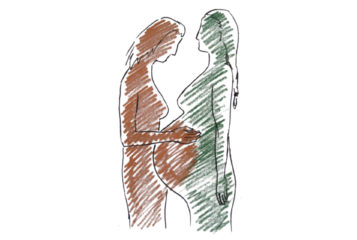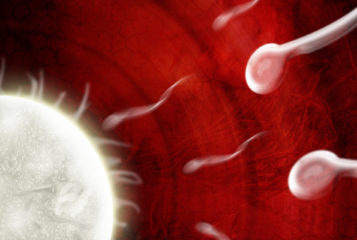|
New Families and Genetic Identities: Developments in Law, Policy and Research Organised by the London School of Economics and Political Science and the University of Manchester Wolfston Theatre, New Academic Building, Lincoln’s Inn Fields, London School of Economics and Political Science, London WC2A 2AE 20-21 June 2013 |
Families are complicated, and no two are the same. It is often said that assisted reproductive technologies (ART) challenge traditional family models. But what has received less attention to date is how these 'new families' navigate the complex thicket of social, legal and policy norms involved in coming to terms with - or understanding - their involvement in ART.
A two-day conference organised by the University of Manchester's Morgan Centre and the London School of Economics (LSE) explored the importance of resemblance, relatedness and genetic connection in families who have used ART and the meaning attached to genes.
Much of the emphasis was on presenting empirical findings (that may have only recently been made possible by a suitable passage of time — and generations — since the birth of Louise Brown in 1978) amid radical developments in law and society. Too much was covered in these two days to justify a review of each session, but some central themes emerged, which I focus on here.
Families
First, the presentations provided a glimpse into whether and how these new families experience their use of ART and attach meaning to biological origin and genetic identity. Professor Carol Smart and Dr Petra Nordqvist from the University of Manchester presented research into the experiences of living with donor conception in heterosexual and lesbian families, highlighting the relative importance of resemblance in each family and the feeling of belonging. These safe or common assurances can be challenged when a child born using donated gametes, or from non-traditional conception, is introduced into the family.
This research emphasised that the wider family is important to how a child feels belonging, to that family and highlighted the multilayered relational bonds that make up the family unit. For these families, genes clearly matter. Our place is important to our ontological security and positioning space, Professor Smart said, but this importance is not necessarily played out in the most logical or rational way.
As much as a child's origins count, the way different family members interpret this varies enormously, and is generated in a complex system of everyday relationships. Perhaps, then, an understanding of kinship rather than lineage can help one to appreciate the meanings of genes in families, suggested Professor Smart. Professor Jennifer Mason, presenting on the second day, said her research showed that resemblance is frequently discussed in families in a combination of potent and trivial forms. It is a force to be reckoned with, not reducible to genes or kinship, she said.
These are 'affinities and alterities' - changing, dynamic and unsettled. They are negotiated, contested, and jostling. As such, it appears that the meaning attached to genetics is necessarily unique to each family arrangement, and any attempt to generalise across the board may lose this crucial aspect.
New scientific discoveries do not write themselves onto blank slates unimpressed by existing cultural framework, explained Professor Smart - there is a great deal of tussle that goes on here. But ART also presents very real challenges. Families also struggle with disconnection where everyday differences are spotted, picking up on preferences that are not matched in the family. These can serve as everyday reminders, for the family, that the child may not be genetically related, and the lack of a genetic connection can give rise to a feeling of loss. From a counselling perspective, Tracey Sainsbury of the London Women's Clinic said that parents and families are seeking certainty and are anxious, with revolving feelings around the donation process. However, in a supportive environment, through bargaining and dialogue, people can deal with issues much better.
What was remarkable about this theme was just how naturally fluid feelings within families were. This 'ability to get on with things' was later highlighted by the University of Kent's Professor Sally Sheldon, who pointed out that although people may hold cultural preconceptions, families have an ability to get on with things and can do so in a flexible and sophisticated way. What emerged from the presentations was a very interesting balance between the unease and vulnerability expressed by some, with a countervailing robustness and resolution to accommodate any potentially threatening differences, either explicit or implicit, into the family 'unit'.
The Law
Another central theme that emerged from the two days was the relative inadequacy of the law's response in ensuring proper recognition of new forms of familial relationships - 'relative', in that the law remains always slow to catch up with fast-paced social change. How can the law, charged with ensuring certainty and clarity, possibly respond to such changes? Messiness can be a significant problem for lawyers, Professor Sheldon pointed out.
There are few people more experienced to provide an overview of the law on parenthood and its application to new families than Baroness Hale, deputy president of the Supreme Court, presenting the first session. The law on parenthood considers the birth mother as the legal mother. For legal fathers, the situation can be remarkably complicated, but the need for determining cases in the best interests of the child requires consideration of parenting roles. However, the rules, designed to ensure a child has two legal parents, interfere with genetic parenthood without consideration of the welfare of the child. The potential gap between how the law operates and how families operate was a key theme that emerged from the conference.
For example, there is a difference between a legal parent and what it means to a child to have a parent, Lady Hale said, remarking also that family networks are an important feature in a child's life. Furthermore, gestational parenthood is not the same as social or psychological parenthood. In response, Natalie Gamble, of the law firm Natalie Gamble Associates, acknowledged that welfare could not be placed any more centrally but the way it is applied in practice can be problematic. The language we have to explain family dynamics is immature, she said.
The conflict between the law's certainty and the fluidity of new family arrangements was neatly summed up in the discussion over birth certificates. The LSE's Dr Julie McCandless highlighted how birth certificates have been justified as a 'true genetic' record of a child's origins, but there is no straightforward view on parenthood or genetic identity. Registration is not just about recording information, she said, but can be seen as something that facilitates the parents' relationship with the child. Perhaps the law needs to catch up with this way of thinking.
Policy
Developing policy in light of such complexity must be quite terrifying. Dr Rhona Knight, chair of the Nuffield Council on Bioethics' working party on donor conception, placed emphasis on values in relationships, saying that openness — telling the child about their biological origin - contributes to the quality of the relationship. The state, in a stewardship role, should support decision making and not remove choice.
The policy of supporting families in reaching their own decisions was an important theme of the conference. Venessa Smith of the London Women's Clinic spoke about her obligations as coordinator of a sperm bank to give the right advice, especially when some people return years later to ask questions about the donor. When patients decide on a donor, the most obvious thing to think about is a physical match, as well as family relatives or parties, she explained. But that has become less important for some lesbian couples who want to match donors to the non-genetic partner, or for single women who want to match according to the partner they want to meet. Interestingly, patients create stories with that donor, she said, and want to continue using them. The bigger picture becomes important - how much information we need to make the right choices.
On disclosure, the University of Cambridge's Professor Susan Golombok presented new data on how donor conceived children understand biological heritance around the age of seven. For those who were told by the age of four or five, no negative reactions were reported. Children do not appear to be distressed by donor conception or surrogacy — they seem to integrate information about the donor conception or surrogacy into their family narratives. This again, seemed to affirm the family's ability to assimilate complex information in an open and supportive environment.
The conference was an interesting in the way it addressed key debates around parenthood, genetic identity and donor anonymity. Debates around assisted conception can at times appear to rest on individualised notions of rights and responsibilities, but, for me, this conference demonstrated that such considerations leave out the influential role played by other family members, and how understanding is partly orchestrated by familial arrangements.
The Nuffield Council on Bioethics, in its recent report on donor information, emphasised the relational nature of familial relationships as consisting of mutual obligations. The report seemed to veer towards convergence, however, and the building of a correct way of doing things. After hearing about the complexity displayed by each family arrangement, I do wonder if searching for any framework is really the most suitable way forward. Families may be able to deal with what is thrown at them, and support and advice is often welcome, but whether there is a need for external quality control is an open question.









Leave a Reply
You must be logged in to post a comment.